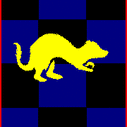Well, no, they've never been officially supported, just condoned by the EULAs. Just if you've wondered, a brief history of modding (possibly oversimplified with errors):
In the beginning there was MCP (Minecraft Coder Project), which, like Forge, was third-party. It provided utilities that decompiled and deobfuscated Minecraft for modding. It was all about "install mods" (aka, "jar mods") -- to install a mod you actually had to open minecraft.jar with a tool for zip files (jar's really are speciallized zip files). If something went wrong the game could break (so you backed up the jar) and if two mods changed the same class they could not be used together -- the second one you installed would break the first by overwriting its changes.
Then came two innovations. One was the mod loader, of which there were several (Rasgumi's, LiteLoader, etc.) -- you could install those mods and then they could load other mods. Second there was Forge, which included APIs and ways to avoid modding base classes directly. Then, Forge added its own built-in Forge Mod Loader (FML). Installing mods in the jar was then obsolete, modding was much safer, and huge modpacks became possible and eventually common. However, modding Minecraft has never been like modding most games -- you really are hacking the games binary either directly or indirectly. With Forge, you can avoid hacking the core game. Still, new release break everything, and force MCP and Forge to fix everything for the new versions; I'm sure all the work is why the Forge team doesn't want to support really old game versions.
I might want to look at the link given above for the details, as I never worried about it too much. But I do know this -- the ability to load new code at run time is part of the Java language, supported through what are called classloaders. Modding if possible because of the nature of the Java language rather than the intentional design or Notch or Mojang. Thus, Forge only works for the "Java edition."

